Abstract
AIMS--A series of patients with myeloma were investigated to assess whether immunological risk factors predisposing to serious infection could be identified. METHODS--Patients (n = 102) with predominantly plateau phase myeloma were monitored prospectively for infections. Immunological parameters including total non-paraprotein immunoglobulins and specific antibody titres were measured in all patients and compared with a control population of healthy individuals of a similar age; response to immunisation with Pneumovax II, tetanus and diphtheria toxoids and IgG subclasses were measured in a subgroup of 41 patients. Other characteristics investigated for any association with infection included age, sex, paraprotein type, disease stage, and chemotherapy. RESULTS--Specific antibody titres to pneumococcal capsular polysaccharides and tetanus and diphtheria toxoids were significantly reduced compared with the control population. Low antipneumococcal and anti Escherichia coli titres correlated with risk of serious infection and low anti-pneumococcal titres with severity of non-paraprotein immunosuppression. In 41 immunised patients responses to Pneumovax II, tetanus and diphtheria toxoids were poor; IgG subclass levels were significantly reduced and a poor IgG response to Pneumovax II immunisation was associated with an increased risk of septicaemia and low IgG2 levels. The overall serious infection rate was 0.92 infections per patient year and was four times higher during periods of active disease (1.90) compared with plateau phase myeloma (0.49). The predominant site of infection was the respiratory tract. Clinical and laboratory parameters showed only male sex and reduced non-paraprotein IgG and IgA levels to be significantly associated with at least one serious infection. CONCLUSIONS--A subgroup of patients with myeloma with poor IgG responses to exogenous antigens, who are at increased risk of serious infection, can be identified and may benefit from replacement immunoglobulin therapy to reduce the risk of infection.
Full text
PDF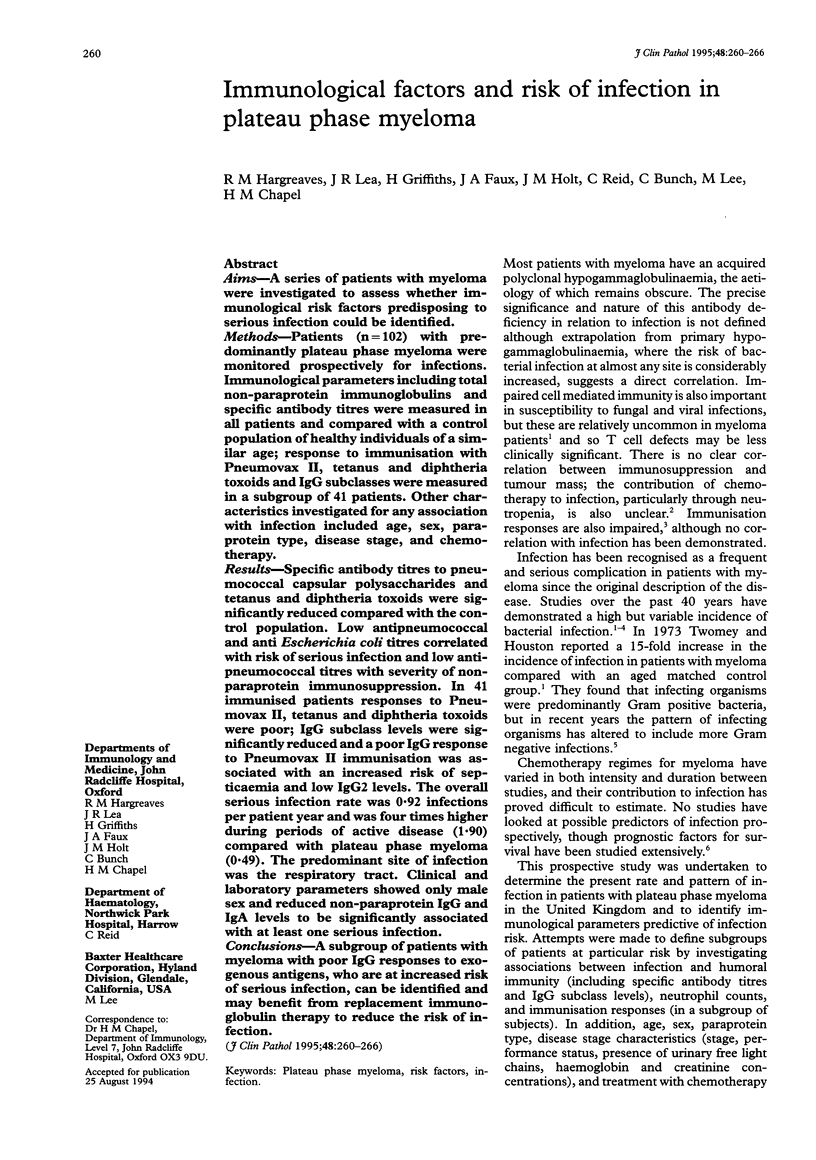
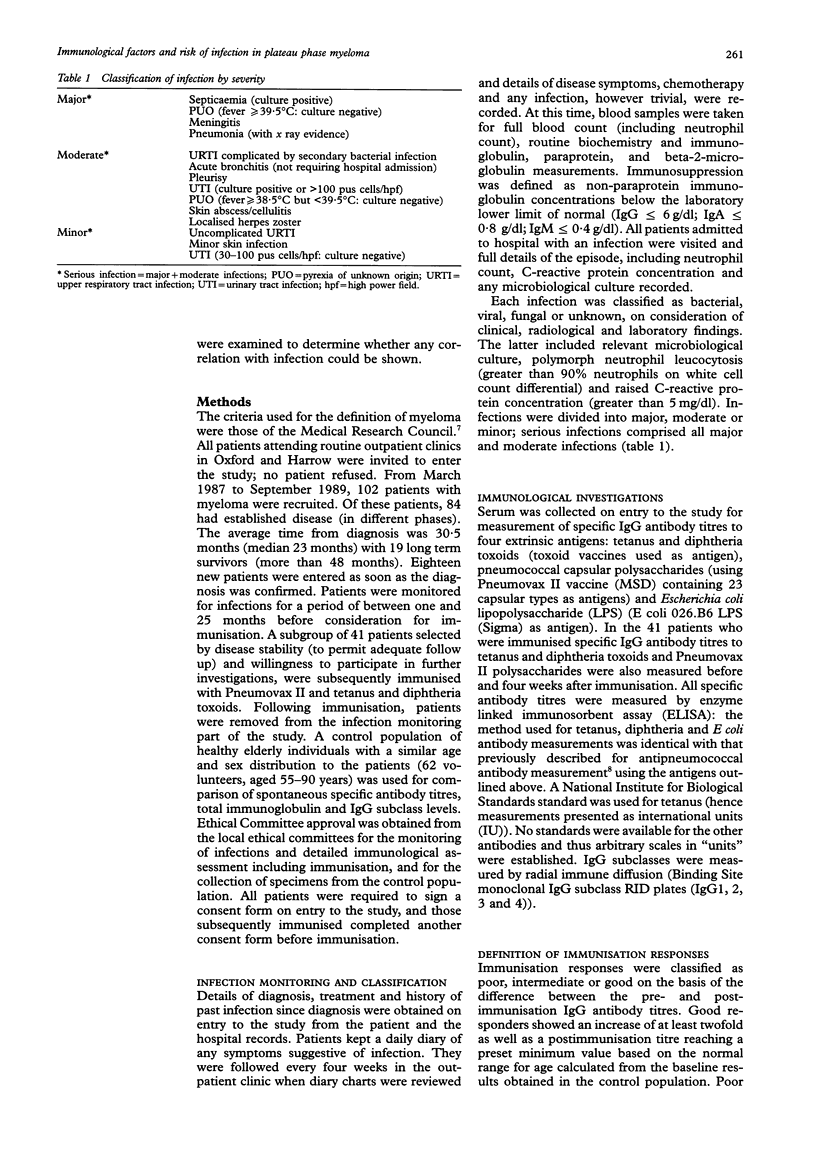
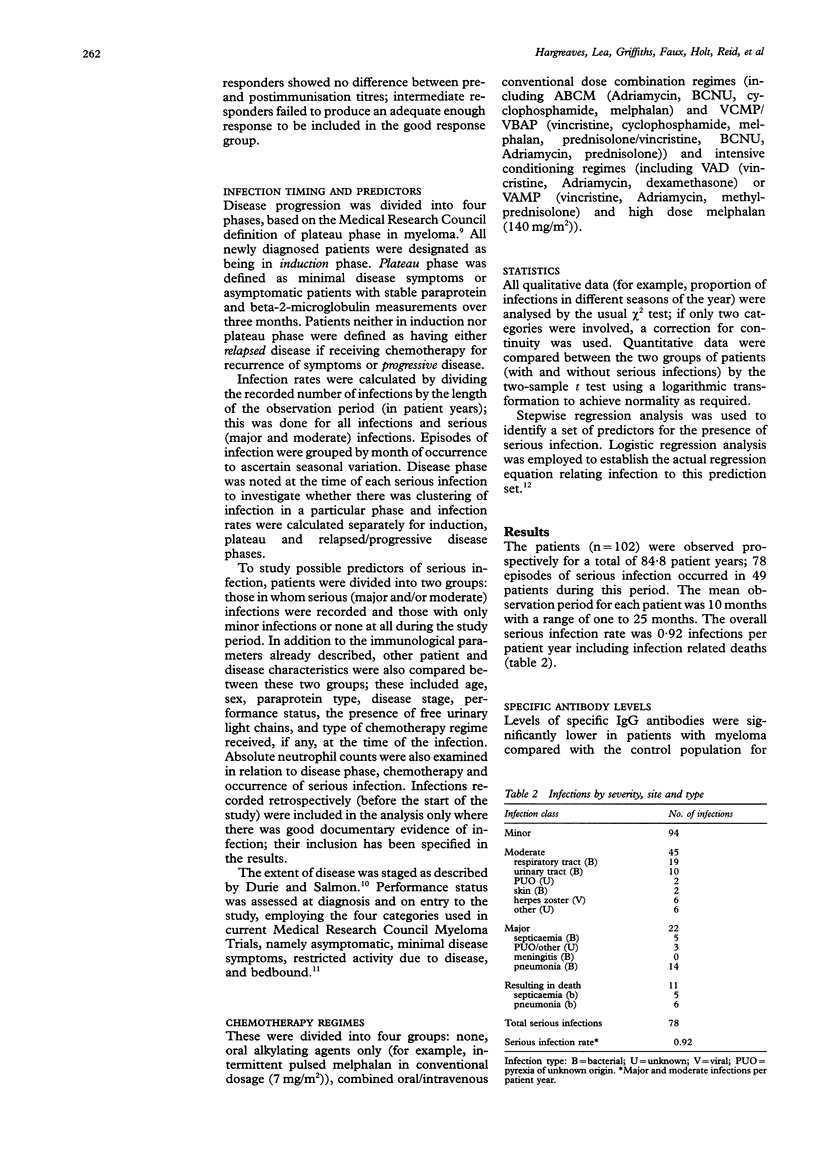
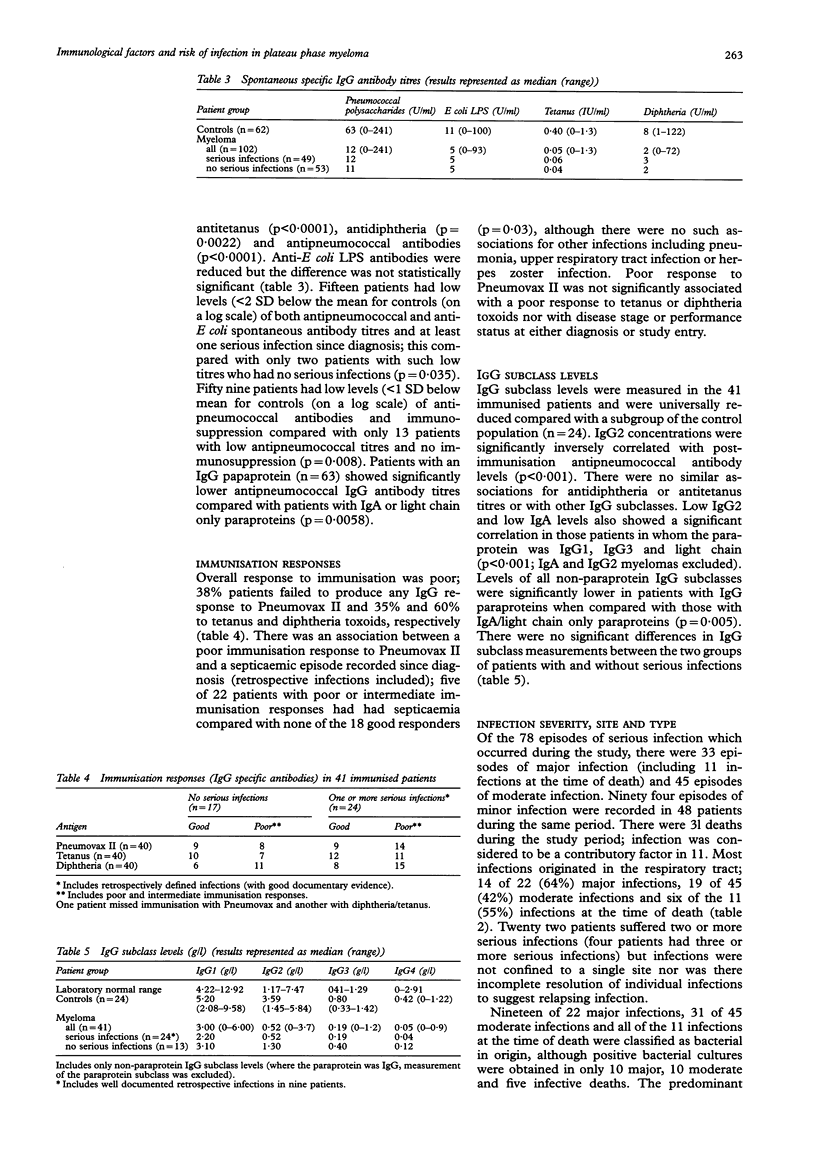
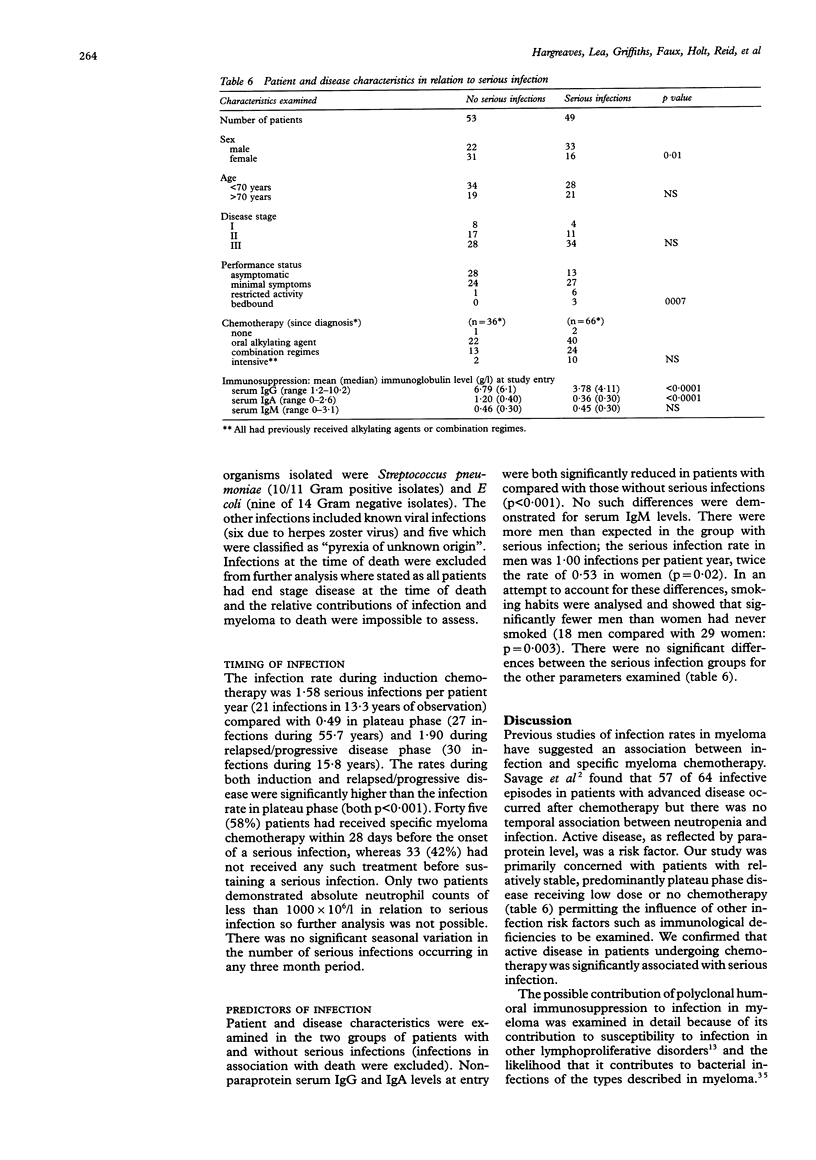
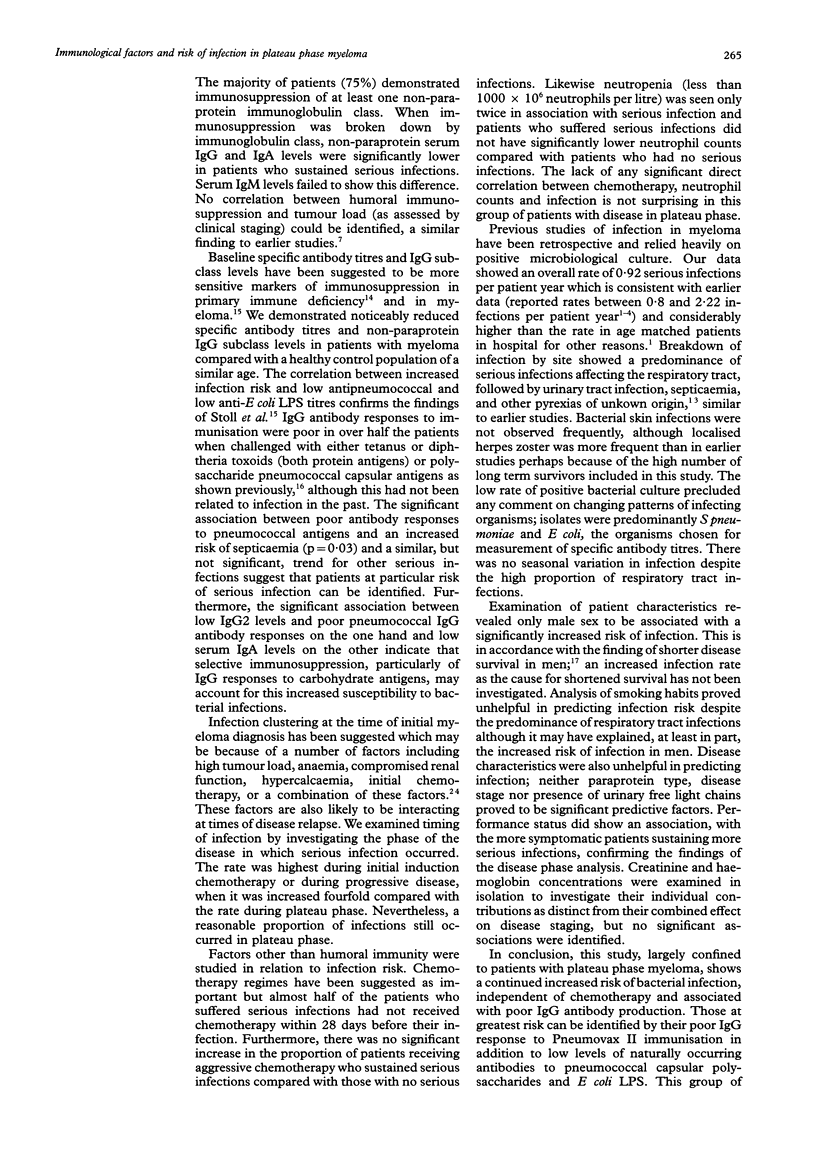
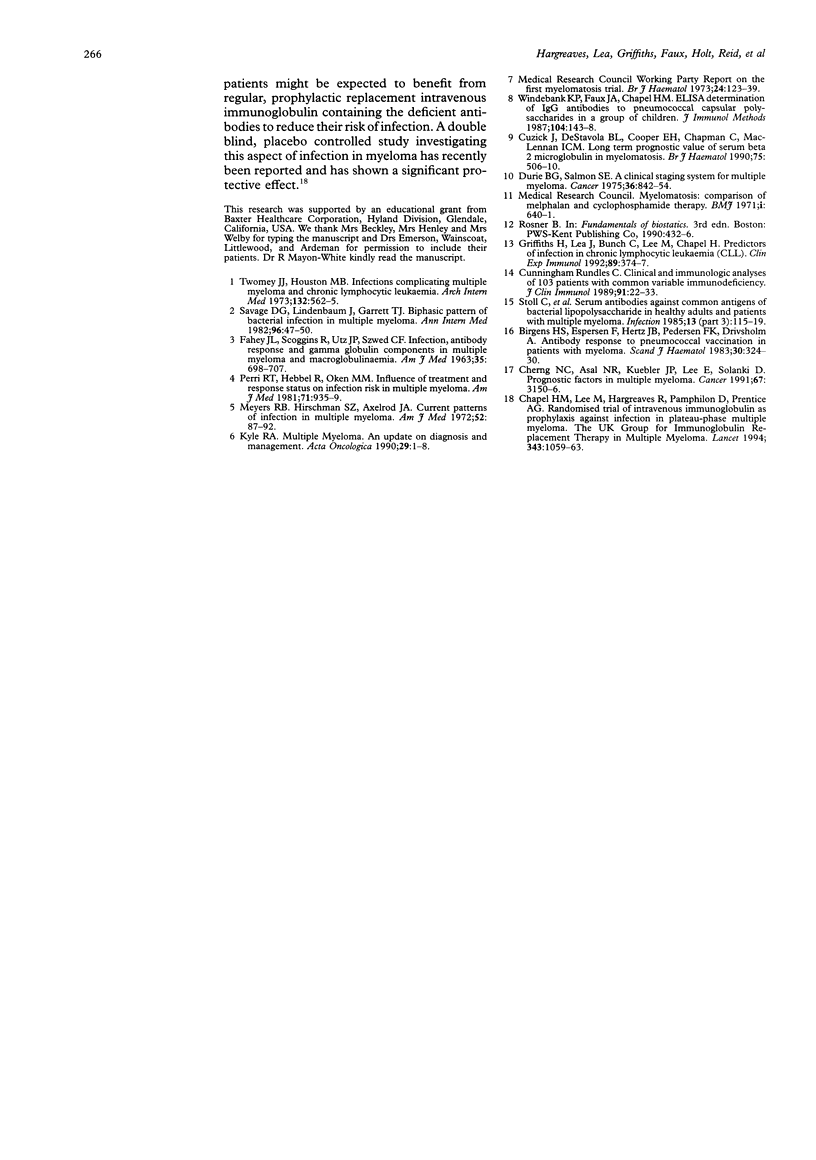
Selected References
These references are in PubMed. This may not be the complete list of references from this article.
- Birgens H. S., Espersen F., Hertz J. B., Pedersen F. K., Drivsholm A. Antibody response to pneumococcal vaccination in patients with myelomatosis. Scand J Haematol. 1983 Apr;30(4):324–330. doi: 10.1111/j.1600-0609.1983.tb01500.x. [DOI] [PubMed] [Google Scholar]
- Chapel H. M., Lee M., Hargreaves R., Pamphilon D. H., Prentice A. G. Randomised trial of intravenous immunoglobulin as prophylaxis against infection in plateau-phase multiple myeloma. The UK Group for Immunoglobulin Replacement Therapy in Multiple Myeloma. Lancet. 1994 Apr 30;343(8905):1059–1063. doi: 10.1016/s0140-6736(94)90180-5. [DOI] [PubMed] [Google Scholar]
- Cherng N. C., Asal N. R., Kuebler J. P., Lee E. T., Solanki D. Prognostic factors in multiple myeloma. Cancer. 1991 Jun 15;67(12):3150–3156. doi: 10.1002/1097-0142(19910615)67:12<3150::aid-cncr2820671236>3.0.co;2-u. [DOI] [PubMed] [Google Scholar]
- Cunningham-Rundles C. Clinical and immunologic analyses of 103 patients with common variable immunodeficiency. J Clin Immunol. 1989 Jan;9(1):22–33. doi: 10.1007/BF00917124. [DOI] [PubMed] [Google Scholar]
- Cuzick J., De Stavola B. L., Cooper E. H., Chapman C., MacLennan I. C. Long-term prognostic value of serum beta 2 microglobulin in myelomatosis. Br J Haematol. 1990 Aug;75(4):506–510. doi: 10.1111/j.1365-2141.1990.tb07790.x. [DOI] [PubMed] [Google Scholar]
- Durie B. G., Salmon S. E. A clinical staging system for multiple myeloma. Correlation of measured myeloma cell mass with presenting clinical features, response to treatment, and survival. Cancer. 1975 Sep;36(3):842–854. doi: 10.1002/1097-0142(197509)36:3<842::aid-cncr2820360303>3.0.co;2-u. [DOI] [PubMed] [Google Scholar]
- FAHEY J. L., SCOGGINS R., UTZ J. P., SZWED C. F. INFECTION, ANTIBODY RESPONSE AND GAMMA GLOBULIN COMPONENTS IN MULTIPLE MYELOMA AND MACROGLOBULINEMIA. Am J Med. 1963 Nov;35:698–707. doi: 10.1016/0002-9343(63)90140-2. [DOI] [PubMed] [Google Scholar]
- Griffiths H., Lea J., Bunch C., Lee M., Chapel H. Predictors of infection in chronic lymphocytic leukaemia (CLL). Clin Exp Immunol. 1992 Sep;89(3):374–377. doi: 10.1111/j.1365-2249.1992.tb06965.x. [DOI] [PMC free article] [PubMed] [Google Scholar]
- Kyle R. A. Multiple myeloma. An update on diagnosis and management. Acta Oncol. 1990;29(1):1–8. doi: 10.3109/02841869009089984. [DOI] [PubMed] [Google Scholar]
- Meyers B. R., Hirschman S. Z., Axelrod J. A. Current patterns of infection in multiple myeloma. Am J Med. 1972 Jan;52(1):87–92. doi: 10.1016/0002-9343(72)90010-1. [DOI] [PubMed] [Google Scholar]
- Perri R. T., Hebbel R. P., Oken M. M. Influence of treatment and response status on infection risk in multiple myeloma. Am J Med. 1981 Dec;71(6):935–940. doi: 10.1016/0002-9343(81)90303-x. [DOI] [PubMed] [Google Scholar]
- Savage D. G., Lindenbaum J., Garrett T. J. Biphasic pattern of bacterial infection in multiple myeloma. Ann Intern Med. 1982 Jan;96(1):47–50. doi: 10.7326/0003-4819-96-1-47. [DOI] [PubMed] [Google Scholar]
- Stoll C., Schedel I., Peest D. Serum antibodies against common antigens of bacterial lipopolysaccharides in healthy adults and in patients with multiple myeloma. Infection. 1985 May-Jun;13(3):115–119. doi: 10.1007/BF01642869. [DOI] [PubMed] [Google Scholar]
- Twomey J. J. Infections complicating multiple myeloma and chronic lymphocytic leukemia. Arch Intern Med. 1973 Oct;132(4):562–565. [PubMed] [Google Scholar]
- Windebank K. P., Faux J. A., Chapel H. M. ELISA determination of IgG antibodies to pneumococcal capsular polysaccharides in a group of children. J Immunol Methods. 1987 Nov 23;104(1-2):143–148. doi: 10.1016/0022-1759(87)90498-4. [DOI] [PubMed] [Google Scholar]


